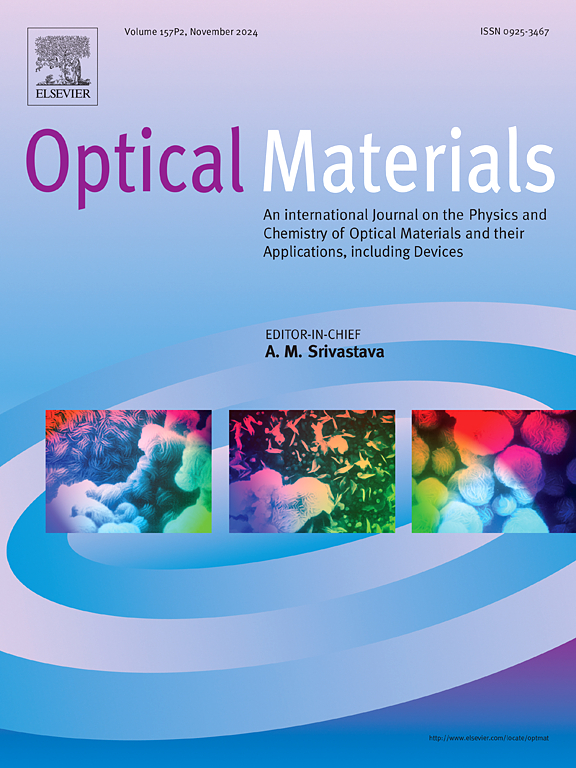The effect of annealing temperature on the properties of CdSe thin films prepared by annealing the SES deposited precursors
IF 4.2
3区 材料科学
Q2 MATERIALS SCIENCE, MULTIDISCIPLINARY
引用次数: 0
Abstract
Cadmium selenide (CdSe) thin films were grown on quartz glass substrates by thermal annealing of thin-film precursors deposited by successive sputtering, evaporation and sputtering (SES) method. The crystal structure, surface morphology, composition, optical and electrical properties of CdSe films were investigated. XRD analysis revealed that the SES deposited precursors after annealing, were converted into hexagonal CdSe films with a preferential orientation. FE-SEM results showed that the CdSe films obtained at 400 °C and 500 °C were dense, uniform and had greater grains than that obtained at 300 °C, while pores and peeling of CdSe film appeared at 600 °C. EDS results showed that all CdSe films were Cd-rich, and the composition of the CdSe film prepared at 500 °C was closest to the ideal stoichiometric ratio. The formation of CdSe films included atomic diffusions, the selenization reaction and CdSe grain growth, accompanied by volatilization of Cd and Se. The CdSe films exhibited good transmittance of about 60–85 % and band gaps of 1.57–1.67 eV. The PL spectra showed that the CdSe films prepared at different temperatures had a strong emission peak at 782 nm and a weak emission peak at 829 nm, which were possibly caused by the band-to-band transitions and defect emissions. In addition, electrical measurements showed that the CdSe films were n-type conductivity, the resistivity was in the range of 9.65 × 102-7.55 × 103 Ω cm, and the carrier concentration was in the range of 5.72 × 1014-2.99 × 1015 cm−3.
退火温度对通过退火 SES 沉积前驱体制备的硒化镉薄膜性能的影响
通过连续溅射、蒸发和溅射(SES)方法沉积的薄膜前驱体的热退火,在石英玻璃基底上生长了硒化镉(CdSe)薄膜。研究了碲化镉薄膜的晶体结构、表面形貌、成分、光学和电学特性。XRD 分析表明,SES 沉积的前驱体在退火后转化为具有优先取向的六边形硒化镉薄膜。FE-SEM 结果表明,与 300 ℃ 时相比,400 ℃ 和 500 ℃ 时得到的硒化镉薄膜致密、均匀且晶粒更大,而 600 ℃ 时硒化镉薄膜出现了孔隙和剥离。EDS 结果表明,所有硒化镉薄膜都富含镉,而 500 ℃ 制备的硒化镉薄膜的成分最接近理想的化学计量比。硒化镉薄膜的形成过程包括原子扩散、硒化反应和硒化镉晶粒生长,同时伴随着镉和硒的挥发。硒化镉薄膜具有良好的透射率,约为 60-85%,带隙为 1.57-1.67 eV。聚光光谱显示,在不同温度下制备的硒化镉薄膜在波长 782 纳米处有一个强发射峰,在波长 829 纳米处有一个弱发射峰,这可能是由带间跃迁和缺陷发射引起的。此外,电学测量结果表明,CdSe 膜具有 n 型导电性,电阻率范围为 9.65 × 102-7.55 × 103 Ω cm,载流子浓度范围为 5.72 × 1014-2.99 × 1015 cm-3。
本文章由计算机程序翻译,如有差异,请以英文原文为准。
求助全文
约1分钟内获得全文
求助全文
来源期刊

Optical Materials
工程技术-材料科学:综合
CiteScore
6.60
自引率
12.80%
发文量
1265
审稿时长
38 days
期刊介绍:
Optical Materials has an open access mirror journal Optical Materials: X, sharing the same aims and scope, editorial team, submission system and rigorous peer review.
The purpose of Optical Materials is to provide a means of communication and technology transfer between researchers who are interested in materials for potential device applications. The journal publishes original papers and review articles on the design, synthesis, characterisation and applications of optical materials.
OPTICAL MATERIALS focuses on:
• Optical Properties of Material Systems;
• The Materials Aspects of Optical Phenomena;
• The Materials Aspects of Devices and Applications.
Authors can submit separate research elements describing their data to Data in Brief and methods to Methods X.
 求助内容:
求助内容: 应助结果提醒方式:
应助结果提醒方式:


